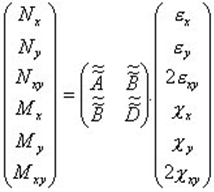
For this kind of calculation, MAC LAM may calculate for a given multi-layered material:
 |
(1)
|
where
,
and
are 3 X 3 matrixes: Nx, Ny and Nxy are the membranar forces; Mx, My and Mxy are the in-plane generalized moments, ex, ey and exy are the generalized in-plane strains; cx, cy and cxy are the curvatures.
where Qx, Qy and Qxy are the generalized shear forces, exz and eyz are the generalized strains associated to the shear forces.
Let's discuss in a more detailed way how to operate MAC LAM in order to obtain the previous results:
Figure 1. Launching STIFFNESSES calculations.
Figure 2. Report of the STIFFNESSES calculation.
Calculation and report options
For the STIFFNESSES calculation type, there are options to which you may access by clicking on "Options" in the menu bar of the main window (see Figure 3).
Figure 3. Calculation and report options of STIFFNESSES calculation type.
Now the window on Figure
4 appears. Select everything you want to have in the report and the way
you want to calculate the out-of-plane stiffness matrix ![]() .
This matrix may be calculated by the inverse of the sum of the compliances of
the layers (as advised in [2] ) or by the layer stiffnesses
sum.
.
This matrix may be calculated by the inverse of the sum of the compliances of
the layers (as advised in [2] ) or by the layer stiffnesses
sum.
Figure 4. Selecting the calculation and report options for the STIFFNESSES calculation type.
Among the options you will find
References
[1] R.M. Jones, "Mechanics of composite materials", second edition,
Taylor & Francis, United States, 1999.
[2] JF.
Caron, K. Sab. Un nouveau modèle de plaque multicouche épaisse.
Comptes Rendus de l'Académie des Sciences Paris II b, 329, 595-600, 2001.